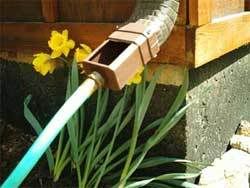Passive Irrigation is one technique that is used in the hydroponicworld. For those of you who are not familiar with hydroponics, itis defined as the act of gardening without the use of soil. Insteadother media is used, or no media and only water is used.
One method of irrigation for hydroponic systems is passiveirrigation (or subirrigation). The growing medium (gravel,vermiclulite, perlite, rockwool, or other pourous material) usedfor this type of irrigation generally has large air spaces. whichallows sufficient amounts of Oxygen to reach the roots of theplants.

The simplest way to construct a hydroponic system with passiveirrigation is to have a container continually sit in a layer ofhydroponic plant nutrient treatment. This plant could sit on acapillary mat as well that is soaked with the right nutrients thatyour plants need. This keeps the medium that you use for growingyour plants flushed regularly with nutrient solution and air.
The simple passive irrigation method described above is thesimplest way for hobby gardeners to get started. It could also be agreat start for commercial farmers on a large scale. You will needto know other information about this type of irrigation as well.
For instance, you need to be aware that it is necessary to wash outthe passive irrigation system from time to time to remove saltaccumulation. You can measure salt buildup in your system with anelectrical conductivity device or a ppm meter. An average readingof 1500 ppm is acceptable, depending upon the plant you will grow.
Some exceptions do apply, however. For instance, lettuce is said togrow well at about 800 ppm and tomatoes are said to grow the bestat about 3000 ppm. Another very important aspect of maintenance of your passiveirrigation system is to make sure you test the pH levelperiodically. It is recommended that it is set at 6.3, but you canfind information, which will tell you the optimal pH settings ofeach one of the plants you intend to grow.
On a larger scale, passive irrigation systems have become a part oflandscape architecture. For example, surrounding some Europeanpublic buildings is a hydroponic system that uses small claygranules for the medium, and small houseplants are grown inside.
An alternative passive irrigation method other than the onesdescribed above includes the use of a wick. This wick runs downfrom the base of the pot or tray of a plant down to a bottle ofnutrient solution. The solution travels up the wick in a similarway that an air freshener scent would to help scent the air. Theuse of the wick is how the plant nutrients are supplied, whichworks in a similar way to the first method described in thisarticle.
Other very important factors of making a hydroponic system work foryou include making sure you have adequate light and adequate space.The forms of light that you can use are natural sunlight andartificial light. Both types of light will produce the right amountof radiation that your plants need. Usually space is not a problem,but you will need at least the minimum amount required for yourplants to grow, which is usually less than for traditional gardens.
A similar type of irrigation is called top irrigation. Using thismethod, a nutrient solution is applied periodically to the mediumsurface, rather than underneath the plant. However, this is moredone automatically, as in the case of most active irrigationssystems. Therefore, it is different than the passive one.
If you want to learn more about hydroponic planting and otherirrigation types besides the passive irrigation you can read morearticles like this one
For more information check out the whole package at homemade-hydroponics.com
The Passive Irrigation Technique Defined through Hydroponics
6:44 AM
ThanateTan







